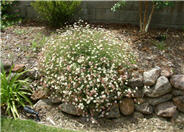
Common name:Lady Banks' Yellow Rose
Botanical name:Rosa banksiae
Lady Bank's Rose is a vigorous climbing vine that will grow to 20' or more. It has glossy, leathery green leaves with large showy clusters of small yellow flowers that bloom in spring. It is essentially thornless and is a good cover for walls, fences or an arbor.

Common name:Deer Grass
Botanical name:Muhlenbergia rigens
The Deer Grass is a warm season perennial that forms dense clumps from the base. The spike-like flower stalks grow 2'-3' tall and this grass has striking foundation form. The Deer Grass is native to California and needs watering once or twice a month after it has been established. The more water it has, the greener it is.

Common name:Mexican Bush Sage, Mexican Sage
Botanical name:Salvia leucantha
The Mexican Sage is a bushy shrub that grows 3'-4' tall and wide. It has hairy white stems, grey-green leaves and velvet-like purple flower spikes that bloom summer through fall. This shrub tolerates sun, light shade, little water, and is hardy to 15 degrees F. The Mexican Sage attracts hummingbirds. Be careful not to overwater. -Cornflower Farms

Common name:California Sycamore
Botanical name:Platanus racemosa
The California Sycamore is a fast growing, deciduous tree that reaches up to 40'-50' high. It tolerates heat, smog, and moist conditions; it is native to riparian areas. It has an interesting mottled bark when the tree is bare in winter. It needs a moderate amount of watering unless the water table is high. Leaves turn yellow in fall before dropping. Hummingbirds and butterflies love the Sycamore.

Common name:Santa Barbara or Mexican Daisy
Botanical name:Erigeron karvinskianus
This low mounding perennial, with fine leaves and white to pinkish daisy-like flowers, is an excellent asset to rock gardens.

Common name:Transvaal Daisy, Gerbera
Botanical name:Gerbera jamesonii
Gerbera jamesonii is a perennial but often grown as an annual. Clumps of tongue-shaped, lobed, 10" long leaves send up slim yet sturdy stems to 1.5' high, each bearing one slender-petaled, 4"-5" daisy.
The natural world works in cycles. Everything is changing form and moving from place to place in an endless energy exchange system. The leaves and twigs that fall to the ground, not to mention other life forms that might die, decompose and combine with water, air and minerals of the soil to create a medium for future plants.
Click in the green box for more information
Designer:
Photographer: GardenSoft
Physical weed control, including mulching, or hand removal protects the watershed from harmful chemicals.
Group plants in your garden according to their water needs (hydrozone).
Develop healthy soil for plants that are vigorous and naturally pest-resistant.